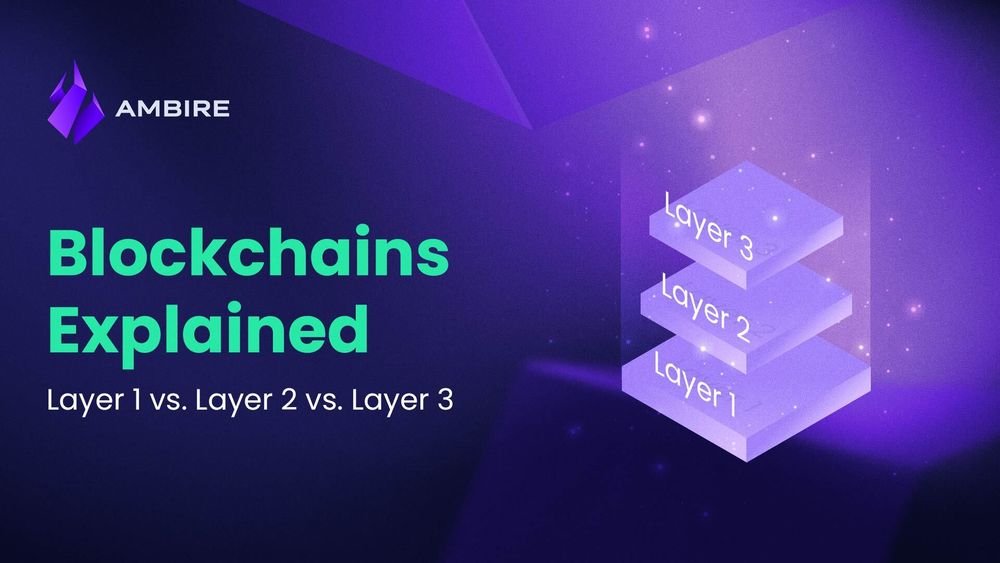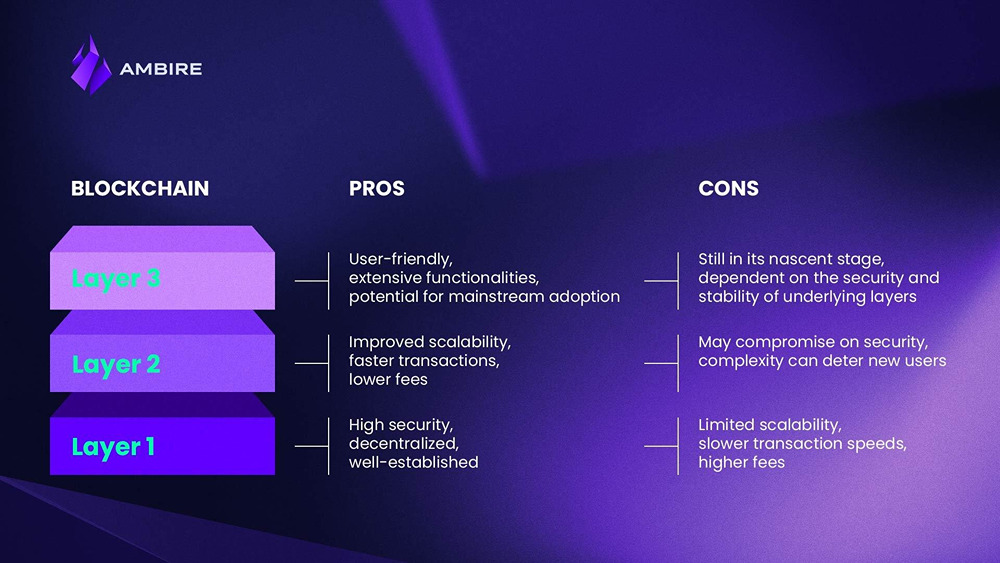Layer 1 vs. Layer 2 vs. Layer 3 Blockchains Explained
Blockchain technology is evolving rapidly, and understanding its layered architecture is crucial. This article demystifies the key differences and functionalities of Layer 1, Layer 2, and Layer 3 blockchains.

Introduction
Various industries have seen blockchain technology as a revolutionary force, from finance to supply chain management. However, as the technology matures, it's becoming increasingly complex, and its fast pace of development means that the need for scalability increases exponentially. One of the most crucial aspects of this complexity and to allow for scalability is the development of different layers within a blockchain. In this article, we aim to provide information on these layers—Layer 1, Layer 2, and Layer 3—by highlighting their key differences, functionalities, and use cases.
Key Differences Between Layers 0, 1, 2, and 3
Blockchain technology can be looked at as a multi-story building, where each layer serves a specific purpose. Layer 0 is the foundational layer, often called the network layer. It handles the basic communication protocols. Layer 1 is the core architecture, Layer 2 adds functionalities, and Layer 3 hosts applications built on these functionalities. These layers differ in key aspects, such as consensus mechanisms, scalability solutions, transaction speed & price, and security features.
What is a Layer 1 Blockchain?
Layer 1 blockchains are the base layer or the foundational blockchains that validate and finalize transactions. They are the original blockchains where everything started. These are decentralized networks that rely on various consensus mechanisms like Proof of Work (PoW) or Proof of Stake (PoS) to validate transactions. Layer 1 blockchains do not depend on any other network.
Examples of Layer 1 Blockchains
- Bitcoin: The first and probably most well-known blockchain, Bitcoin operates on a PoW mechanism and is primarily used for peer-to-peer transactions.
- Ethereum: Known for its smart contract functionality, Ethereum started with PoW but is transitioning to a PoS mechanism.
- Polkadot: This multi-chain blockchain platform uses a variant of PoS and aims to enable different blockchains to interoperate.
Each blockchain operates at the base layer and has its own native tokens, consensus mechanisms, and smart contract capabilities.
What are the downsides of Layer 1?
Despite their foundational importance, Layer 1 blockchains are not without challenges. They often face the so-called scalability trilemma, which is the trade-off between decentralization, security, and scalability. It would be near impossible to have all 3 and still be competitive, so usually, a compromise is made to allow for one or the other.
Moreover, transaction speeds can be slow, and fees can be high, especially during network congestion. The high computational resources most Layer 1 blockchains require are often to blame for this. These limitations often result in a less efficient user experience and are the primary reasons for the development of Layer 2 solutions.
What is a Layer 2 Blockchain?
Layer 2 blockchains are secondary frameworks or protocols created on top of an existing blockchain. These layers aim to solve the inherent limitations of Layer 1 blockchains, primarily scalability issues. Layer 2 solutions are not standalone blockchains but rely on the underlying Layer 1 for their security and finality. They act as a second layer of protocols that process transactions off-chain or in a more efficient manner before settling the final state on the Layer 1 blockchain.
Being able to offer speed of transactions and reduced cost without compromising on decentralization makes them crucial for the whole Web3 ecosystem as they pave the way for mass adoption.
Many projects that started on Layer 1 blockchains now incorporate Layer 2 solutions to facilitate their users. Ambire Wallet, e.g., supports 10+ EVM chains with integrated bridges. Using Layer 2 networks, as well as Account Abstraction, it has features to reduce gas fees and to increase the speed of transactions, e.g., batching multiple transactions into one and the unique Gas Tank. The Gas Tank allows you to prepay for gas fees in stablecoins or other tokens - which you can then use across any supported network and save.
Types of Layer 2 Blockchains
Rollups
Rollups are a promising Layer 2 solution that aggregate multiple transactions into a single transaction roll. This aggregation significantly reduces the load on the main chain, making it a crucial technology for high-throughput environments where speed is of the essence. There are two main types of rollups: zk-rollups and Optimistic Rollups. While zk-Rollups use zero-knowledge proofs for validation, Optimistic Rollups use fraud proofs. Both aim to improve transaction speed and reduce costs.
Sidechains
Sidechains are independent blockchains that run in parallel to the main chain. They are designed to allow for faster and more scalable transactions, often tailored for specific use cases that the main chain can't handle efficiently. Sidechains have their own consensus mechanisms and can have different features and functionalities than the main chain. However, they often rely on the main chain for security, which means they might be less secure than Layer 1 blockchains.
State Channels
State channels are like private roads that allow users to transact among themselves without going through the main chain. This off-chain approach significantly reduces transaction fees and speeds up the process. Once the series of transactions is complete, the final state is updated on the main chain. State channels are particularly useful for microtransactions and are commonly used in gaming and streaming services.
Nested Blockchains
Nested blockchains are a more complex form of Layer 2 solutions that involve multiple sidechains connected under a parent chain. This hierarchical structure allows for increased scalability and transaction throughput. Nested blockchains can have their own consensus mechanisms, features, and functionalities, making them highly customizable. They are often used in enterprise solutions where different departments or units may require their own blockchain but still need to be connected to a central chain.
What is a Layer 3 Blockchain?
Layer 3 blockchains serve as the application layer where decentralized applications (dApps) are built. These are the interfaces that end-users interact with and are built on top of Layer 2 or even Layer 1 solutions. Layer 3 solutions aim to make blockchain technology more accessible and user-friendly. They often include user interfaces, wallets, and other user experience enhancements that make interacting with the blockchain easier for the average person.
Examples of Layer 3 Blockchains
- Decentralized Finance (DeFi): Platforms like Uniswap and Sushiswap allow users to trade cryptocurrencies and earn interest through liquidity mining.
- NFT Marketplaces: OpenSea and Rarible are platforms where users can buy, sell, and trade non-fungible tokens (NFTs).
- Decentralized Autonomous Organizations (DAOs): Aragon and DAOstack are platforms that allow users to create and manage decentralized organizations.
Pros & Cons of Using Each Type of Blockchain

Layer 1
- Pros: High security, decentralized, well-established.
- Cons: Limited scalability, slower transaction speeds, higher fees.
Layer 2
- Pros: Improved scalability, faster transactions, lower fees.
- Cons: May compromise on security, and complexity can deter new users.
Layer 3
- Pros: User-friendly, extensive functionalities, potential for mainstream adoption.
- Cons: Still in its nascent stage, dependent on the security and stability of underlying layers.
Conclusion
Understanding the intricate layers of a blockchain is crucial for anyone involved in this rapidly evolving space. Each layer offers unique advantages and comes with its own set of challenges. When choosing a blockchain solution, it's essential to consider various factors like scalability, security, and transaction speed. As blockchain technology continues to mature, we can expect even more layers and sub-layers to emerge, each with its own set of features and functionalities, further enriching this already complex but promising ecosystem.
Interested in Ambire? Follow us:
Discord | X (Twitter) | Reddit | GitHub | Telegram | Facebook
